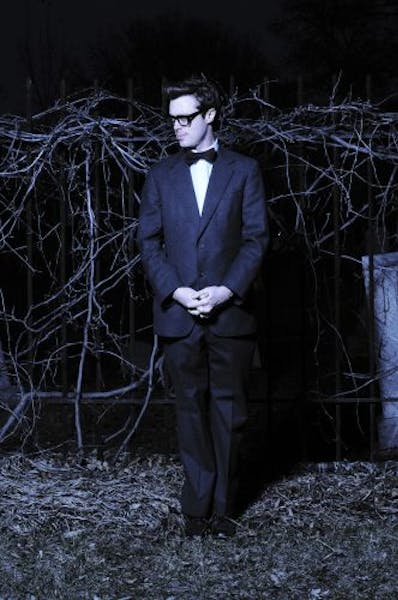How perfect a location does this sound for a concert on a golden Saturday afternoon: 27 gently sloped acres with thick grass, color-bursting trees and historic monuments just off the Midtown Greenway in south Minneapolis?
The only deterrent might be the 20,000 dead people who reside there.
Two of the Twin Cities' favorite young nightclub performers, Jeremy Messersmith and Lucy Michelle & the Velvet Lapelles, are taking their acts outside for an unusual concert in the historic Minneapolis Pioneers and Soldiers Cemetery.
Proceeds benefit preservation efforts in the cemetery, home to Minneapolis' first native African American, four War of 1812 vets and more stories than your average library.
What sounds like a quirky, one-time thing could turn into a serious annual effort modeled after popular graveside events in New York and Los Angeles. Minneapolis city staff even took pointers from the Hollywood Forever Cemetery, which has hosted concerts by such big-name acts as the Flaming Lips and Bright Eyes, and now has movies in the park.
"We knew we needed to get creative with ways to raise money for maintaining the property," said Aaron Hanauer, senior city planner in Minneapolis' preservation division. "This certainly is creative."
The 158-year-old, city-owned Pioneers and Soldiers Cemetery -- a quiet oasis on the bustling corner of Cedar Avenue and Lake Street -- became an unlikely wellspring of inspiration for Messersmith's highly publicized 2010 album, "The Reluctant Graveyard." A nearby resident, Messersmith said he often strolled the cemetery while making the album, "just because it's the nearest green space to where I live."
"It's like a park that nobody ever goes to, a good place to clear your head," said Messersmith, a poppy indie-rocker favored on the Current (89.3 FM) -- not the ghoulish heavy-metal musician you might imagine rocking a graveyard.
Messersmith's inspiration led city staff and the volunteer group Friends of the Cemetery to reimagine the green acres as a park or public-use facility.
Saturday's event will feature a "smartphone history hunt," in which visitors will get clues from tombstones on their mobile phones. Future ideas to draw in visitors include walking tours with actors portraying the cemetery's residents, and perhaps more concerts.
This inaugural gig is specifically timed to the Partners in Preservation campaign on Facebook. The public can vote online for one of 25 historic sites in the Twin Cities area to receive a $1 million grant through the National Trust for Historic Preservation. All 25 sites are hosting open-house events this weekend.
Only one is hosting a rock concert, though.
"When I tell people what we're doing, their jaws usually drop," said Sue Hunter-Weir, who heads Friends of the Cemetery. "But when they hear the whole story -- that it's being done in a tasteful way, and will help out the cemetery -- they understand it's a good idea."
Ticket sales will go toward Friends of the Cemetery's $1-million-plus project to restore the steel and limestone-pillar fence. A lot more work is needed, though, Hunter-Weir said.
Like Messersmith, Hunter-Weir was drawn into the cemetery's history and serenity when she moved to the Phillips neighborhood 15 years ago. She has since become its de facto historian and champion. A few months ago, she helped a woman discover that six of her relatives in the cemetery died during a smallpox epidemic in 1902.
"You can trace the history of what was going on in Minneapolis and who was living in the city through the people buried there," Hunter-Weir said.
Robert Panning-Miller, a history teacher at Minneapolis South High School, has been bringing his students to the cemetery for 15 years. Biology and English classes also use it (you can just imagine the Edgar Allan Poe-style prose born off the latter).
"There are many great teaching resources there, and it just happens to be two blocks away," said Panning-Miller, who recruited students to volunteer as staff for the concert -- an unusual request to run past their parents, he admitted. "It sounds a little weird at first, but it really is a great way of connecting them to their community."
Messersmith named one especially sweet ballad on his album, "Toussaint Grey, First in Life and Death," after an 8-year-old buried there who is believed to be the first black resident born in the city.
"I kind of stole [the cemetery's] historical riches for my own artistic purposes, so I probably do owe it some payback," he said.
He plans to perform his "Graveyard" album in its entirety, and to throw in another song or two appropriate for a cemetery. However, Messersmith promised: "I won't be playing 'Thriller,' which everyone is suggesting I do."
All in good taste.
Chris Riemenschneider • 612-673-4658
In heated western Minn. GOP congressional primary, outsiders challenging incumbent

Minnesota Sports Hall of Fame: A class-by-class list of all members

This retired journalist changed professional wrestling from Mankato

